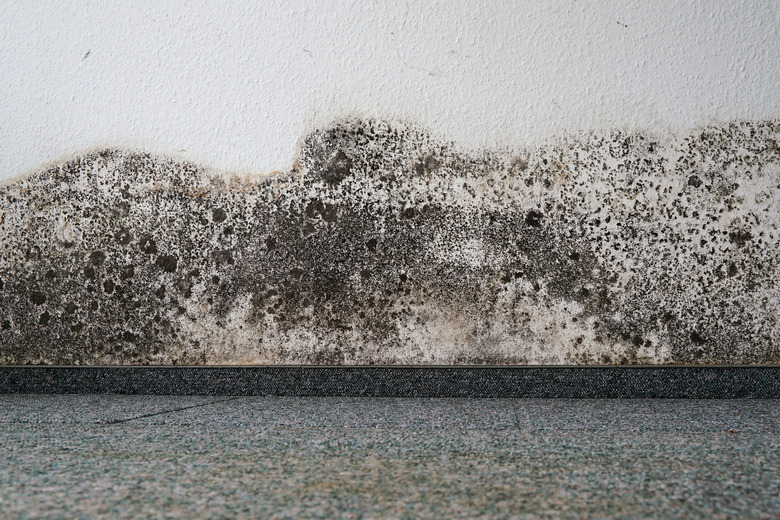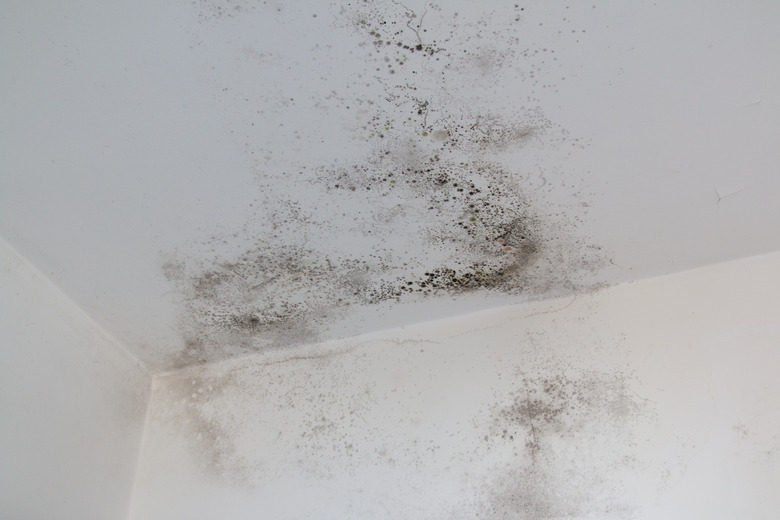The 10 Common Causes Of Mold Growth In The House — And How To Prevent Them
We may receive a commission on purchases made from links.
Mold spores are all over, both indoors and outdoors, but it takes an ideal environment for them to grow. Moisture is one necessary component for mold spores to reproduce, which is why the common causes of mold growth in your home all relate to humidity or water (which is, of course, everywhere in your home). Most household mold is harmless, but toxic mold is one type that can potentially cause health issues. Understanding how and why mold grows helps you reduce the chances of it growing in your home.
Common molds and mildew can start growing in 24 to 48 hours after materials become wet — and darkness and warm temperatures help the mold grow even faster. Many materials found in your home, including paper, wood, insulation, drywall, carpet, upholstery and organic material, offer a food source for all types of mold, including black mold. And, once household mold starts growing, it doesn't stop until you do something about it.
1. Home Roof Leaks
1. Home Roof Leaks
Water leaks from the roof are common, especially if your roof is older. Worn shingles, leaky flashing and rotten decking are possible sources of roof leaks. Rain filters into the damaged roofing materials, where it can get trapped and create moist conditions that are ideal for mold growth.
Water can also leak through your roof and into your attic, soaking insulation, joists and the ceiling of the room below, creating more potential for mold growth. Roof leaks aren't always easy to spot unless you have water dripping through the ceiling, which means the mold can grow undetected for a long time, making the mold problem worse. The best way to prevent mold growth from a leaky roof is to ensure that all of your shingles, flashing and decking are not in disrepair — and checking its condition after a major weather event.
2. Leaks Inside Your Home
2. Leaks Inside Your Home
Your indoor plumbing is a common source of leaks that lead to water damage and potential mold growth — and they can happen just about anywhere along your plumbing pipes. It's easy to spot leaks under the sink, but you might not notice when pipes leak inside walls or in unfinished areas, such as the crawl space. If your home has hidden plumbing leaks, you might not realize you have an issue until mold growth is well-established.
You likely can't prevent every plumbing leak in your home, but you can do periodic checks around your house to spot them before they gradually grow worse — leading to major mold growth. Look for things like wet drywall, pooled water on the floor and peeling paint.
3. Poor Home Ventilation
3. Poor Home Ventilation
When you have poor ventilation in your home, moisture from normal activities — such as showering and cooking — builds up indoors. Stagnant, moist, warm air creates an ideal environment for mold growth so increasing airflow can help moisture escape to lower the chance of mold growth while improving indoor air quality.
Using exhaust fans in your kitchen and bathrooms helps improve ventilation (and yes, this means running it every single time you take a shower or a bath). Because those areas naturally have higher humidity levels, running an exhaust fan that's vented outdoors helps remove the excess moisture from the room. Opening windows can also help improve ventilation and let excess moisture escape while improving air circulation.
4. Mold Growth From Flooding
4. Mold Growth From Flooding
Your home can experience flood damage from exterior water due to natural flooding or from inside the home if you have a major plumbing leak (like from a hot water heater or a washing machine). Floodwaters can saturate everything in your home and lead to rapid and widespread mold growth. Since mold starts growing so quickly and floods take time to clean up, it's possible to have large amounts of mold growing once the floodwater is gone.
Severe flood damage might require you to tear out drywall, flooring and other materials anyway due to the water damage, and anything that can be salvaged could potentially grow mold if it's not cleaned and dried properly.
You can't prevent a natural disaster from damaging your home, but you can make some modifications to make your home safer from a flood — like installing backflow valves and moving your hot water heater to higher ground. This won't entirely prevent damage, but it can stop it from completely wreaking havoc.
5. Persistent High Humidity
5. Persistent High Humidity
Normal humidity levels in a home range from 30 to 50 percent, and higher humidity levels can cause mold and mildew growth throughout your house. So, what causes high humidity in the home? Cooking, showers, humidifiers and plants are just a few sources. If your humidity levels are high, you'll likely feel uncomfortable and notice condensation forming on your toilet tanks and other surfaces. (Unsure of what your humidity levels are? A hygrometer is a simple tool that measures humidity levels for you.) Sometimes, the humidity problem only affects part of the house, but often high humidity is an issue in every room.
If your home has high humidity, using a dehumidifier (in addition to exhaust fans in the kitchen and bathrooms) can help reduce the moisture levels and reduce the risk of a mold problem.
6. Dampness in the Basement
6. Dampness in the Basement
A damp basement is often prone to mold, as every homeowner with a basement is well aware. Moisture that seeps through concrete walls combined with limited ventilation create an ideal environment for mold. Finishing a basement with moisture issues can make a mold problem go from bad to worse because it gives the spores plenty of areas to grow (making it crucial to check for moisture issues before you start to renovate). In finished basements, moisture can build up behind your drywall, under carpet and in other materials, where mold grows over time.
The best way to fix moisture issues in the basement (and prevent mold growth) is to remedy poorly graded lawns, which can direct water toward your home's foundation and increase the chances of water entering the space. It's also a good idea to check if the gutters are clogged, as this can make water overflow near the foundation and head into your basement.
7. Too Much Condensation
7. Too Much Condensation
When warm air and cold surfaces collide, you get condensation. It happens frequently on windows — especially when there's a big difference between the indoor and outdoor temperature. For example, condensation can form when heated indoor air meets a cold, leaky window in the winter, and it eventually causes mold to grow on the window sills and trim. Other places where condensation can often accumulate include cold concrete floors and metal pipes. If condensation is a consistent occurrence, the moisture can cause mold to grow in those areas.
The best way to fix condensation issues are to run a dehumidifier, insulate your windows and run your exhaust fans when you cook or shower.
8. Insulation
8. Insulation
Insulation helps control the temperature inside your home, and inadequate insulation can indirectly lead to mold problems. Not having enough insulation in the attic can warm the roof deck and contribute to ice dams (AKA icicles) in cold, snowy climates. Ice dams commonly lead to roof leaks and water getting into the attic, which adds to the potential for mold formation. Insulation inside walls can become wet from leaks in the siding or other exterior elements. If any insulation is moldy, you'll need to remove it and have the appropriate amount of insulation added to prevent any further mold growth.
9. HVAC System Problems
9. HVAC System Problems
Issues with your HVAC system can cause excess moisture throughout the home. Ductwork for the system is dark and often humid, which creates ideal conditions for mold growth. Trapped dust and other debris can add to the problem, holding onto moisture and mold spores. A lack of insulation on the ductwork or improper sealing at the duct joints can contribute to condensation in the ducts.
An air conditioning unit that's too large for your home can also cause humidity issues. When working correctly, a properly sized air conditioner helps remove humidity from the air. When it's oversized, the AC shuts off and turns on frequently instead of running on the normal longer cycles. This means the unit doesn't run long enough to remove the humidity effectively.
If your home has mold growth due to your HVAC system, work with a pro to determine the best way to fix it — whether that be re-sizing an air conditioning unit for your home's size or cleaning out your air ducts.
10. Wet Clothing Piles
10. Wet Clothing Piles
Wet towels, swimming suits and other clothes can turn moldy quickly if they're left in a pile because tossing wet items in a laundry hamper or in a pile on the floor doesn't allow them to completely dry. Mold spores can grow in the clothes, and the mold can spread to flooring or anything else the wet clothes touch. Letting clothes dry fully before putting them in the hamper or washing them immediately prevents this mold issue.
References
- Mr. Rooter Plumbing: Causes of Mold in Your Home and How to Prevent It
- U.S. Environmental Protection Agency: A Brief Guide to Mold, Moisture and Your Home
- Centers for Disease Control and Prevention: Basic Facts About Mold and Dampness
- Federal Emergency Management Agency: Dealing With Mold & Mildew in Your Flood Damaged Home

